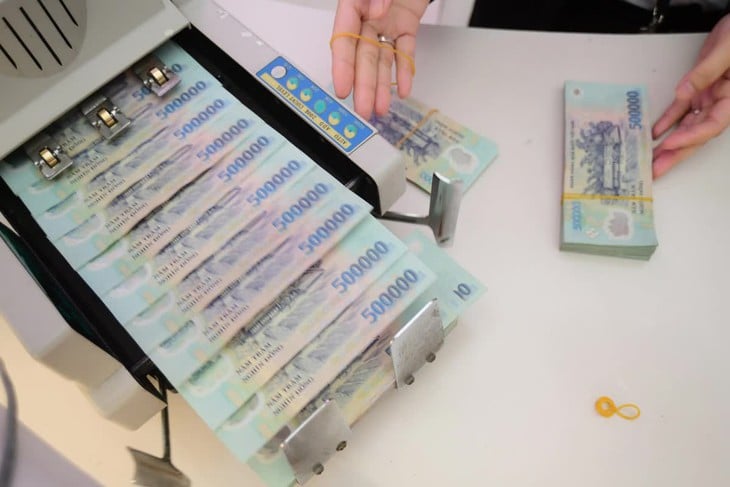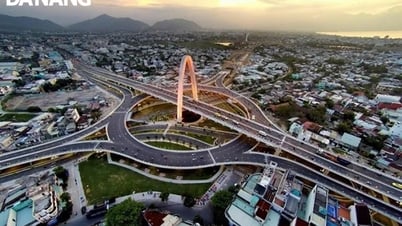
Bad debt to increase further in the first quarter of 2025 - Photo: QUANG DINH
On June 9, Vietnam Report announced the ranking of Top 10 prestigious Vietnamese commercial banks in 2025.
Vietcombank continues to lead the rankings, followed by Techcombank, VietinBank, BIDV, MBBank, Agribank, ACB , HDBank, VPBank and Sacombank.
Banking industry profits over 260,000 billion VND, 5 "big guys" account for half
Also according to a report from Vietnam Report , commercial bank profits in 2024 will reach a record of more than VND 260,000 billion, an increase of 16.8% over the previous year - an impressive increase compared to an increase of less than 4% in 2023.
The accumulation of positive business results has helped another bank join the group of banks with total assets of over 1 quadrillion VND. The total after-tax profit of the 5 largest banks in the market currently accounts for about 50% of the entire commercial banking system.
Vietnam Report analysts say the profit gap between large and small banks is becoming increasingly evident.
While medium and large banks continue to maintain growth momentum thanks to large credit scale, good mobilization capacity and stable customer base, small banks face difficulties due to high capital costs and pressure from increasing bad debt.
Notably, the group of banks with total assets under VND300,000 billion recorded negative profit growth of up to 11.5%.
By 2025, the banking industry is assessed to have many development opportunities as macro policies are aiming to turn Vietnam into a modern industrialized country with an upper middle income by 2030, and move towards the high-income group by 2045.
The report points out five major growth opportunities for the industry, including: promoting the development of digital financial products; accelerating digital transformation; positive prospects for the Vietnamese economy ; newly revised legal frameworks; and reform and streamlining of the state management apparatus.
Asset quality expected to improve, but group 5 bad debt is worth noting
Besides profits, the report also highlighted positive signals about asset quality in the banking system as the economy recovers and bad debt pressure decreases.
The industry-wide bad debt ratio peaked in the second quarter of 2023, then was somewhat controlled thanks to the policy from Circular 02 of the State Bank.
In 2024, the situation will continue to improve thanks to low interest rates, business recovery, and gradually restructured debts. The bad debt ratio is generally around 1.93-2.22%.
However, some banks still reported bad debt ratios exceeding 4%, with some even recording bad debt exceeding 14% in the first quarter of 2025, despite a sharp decrease from 35.3% in the same period last year.
In absolute terms, the total bad debt of the entire system by the end of the first quarter of 2025 exceeded VND 300,000 billion, an increase of 16.8% over the same period in 2024 and an increase of 13.4% over the beginning of the year.
Experts warn that the risk of bad debt still exists when Circular 02 officially expires from January 1, 2025. At that time, restructured debts will no longer be preferential and will have to be reclassified, possibly pushing a large amount of debt into the bad debt group.
The bad debt structure in the first quarter of 2025 shows that group 5 debt (possibility of capital loss) increased sharply, accounting for 1.25% of total outstanding loans, equivalent to more than 176,000 billion VND. This level is higher than the total bad debt of the entire system at the end of 2022 and increased by 10.7% compared to the beginning of 2025.
However, Vietnam Report assessed that the current increase in bad debt is still under control thanks to banks proactively and prudently setting aside credit risk provisions. In the first quarter of 2025, the total risk provisions of the banking system will reach about VND253,000 billion, covering 84.4% of bad debt.
In 2024 alone, provisioning costs reached VND163,200 billion, up 13.1% over the previous year. The bad debt coverage ratio (LLR) of banks has generally remained stable, although it has shown a downward trend and has fallen below 100% since the third quarter of 2023. To date, LLR has not yet recovered to the ideal level to ensure profit targets.
It is also worth noting that there is a clear differentiation in the reserve buffers between banking groups. The group of banks with total assets of over VND1,000 trillion still maintains an LLR ratio of over 125%, although it is also under downward pressure. Meanwhile, small-scale banks (total assets of under VND300,000 billion) have very low LLR ratios, which fell to a bottom of 29% in the second quarter of 2024 and have only recently recovered to around 38%.
Source: https://tuoitre.vn/no-xau-co-kha-nang-mat-von-hon-176-000-ti-dong-lap-ky-luc-20250609180112702.htm




























![[Photo] Prime Minister Pham Minh Chinh receives leaders of several Swedish corporations](https://vphoto.vietnam.vn/thumb/1200x675/vietnam/resource/IMAGE/2025/6/14/4437981cf1264434a949b4772f9432b6)



































































Comment (0)